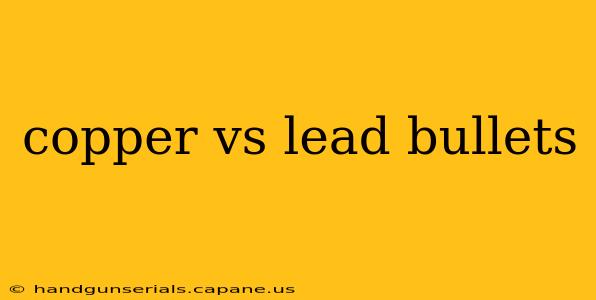Choosing the right ammunition is crucial for any shooter, whether you're a hunter, target shooter, or self-defense enthusiast. Two dominant materials in bullet construction are copper and lead, each boasting unique properties that influence ballistics, environmental impact, and cost. This in-depth comparison will explore the key differences between copper and lead bullets to help you make an informed decision.
Ballistic Performance: Accuracy, Velocity, and Expansion
Lead Bullets: Lead is a relatively soft and dense metal, offering good ballistic coefficients at lower velocities. This translates to decent accuracy and predictable trajectories, particularly at shorter ranges. However, lead's softness can lead to deformation upon impact, potentially affecting accuracy at longer ranges or with higher velocities. Lead's density also contributes to its superior stopping power at lower velocities compared to copper, making it a favored choice for hunting certain game.
Copper Bullets: Copper is significantly harder than lead, resulting in higher retained velocity and superior accuracy, especially at longer ranges and higher velocities. This hardness also contributes to greater bullet integrity upon impact, reducing deformation and maintaining trajectory. While copper bullets might not have the same stopping power as lead at lower velocities, their retained energy at longer ranges can be advantageous in hunting situations. Many copper bullets are designed with features that promote controlled expansion, maximizing their effectiveness on game.
Expansion and Fragmentation
The expansion characteristics of each bullet type significantly impact their effectiveness on target. Lead bullets, being softer, often deform and mushroom upon impact, transferring energy to the target. However, this deformation can also lead to inconsistent expansion. Copper bullets, due to their hardness, often rely on design features like hollow points or bonded cores to control expansion, resulting in more predictable and consistent performance. Fragmentation is generally less common with properly designed copper bullets compared to lead, although this depends heavily on bullet design and velocity.
Environmental Impact: Toxicity and Biodegradability
This is a crucial consideration for environmentally conscious shooters.
Lead Bullets: Lead is a well-known neurotoxin, and the use of lead ammunition has raised concerns about its impact on wildlife and ecosystems. Lead fragments left in the environment can contaminate soil and water sources, posing a risk to animals and humans alike. Furthermore, lead is not biodegradable.
Copper Bullets: Copper is considerably less toxic than lead and is generally considered more environmentally friendly. While not biodegradable, copper is a naturally occurring element that is less likely to cause the same level of environmental contamination as lead. In many instances, copper bullets are favored for their reduced environmental impact.
Cost and Availability: A Price Comparison
Lead Bullets: Historically, lead has been significantly cheaper than copper, making lead bullets a more budget-friendly option. However, this price difference has been narrowing as the demand for copper bullets increases.
Copper Bullets: Copper bullets generally command a higher price due to the cost of the material and often more complex manufacturing processes. Availability may also be a consideration, as the supply of copper bullets may not always match the demand, particularly for specific calibers and bullet types.
Conclusion: Choosing the Right Bullet
The choice between copper and lead bullets depends heavily on your specific needs and priorities. Lead bullets offer a cost-effective solution with good stopping power at shorter ranges, but come with significant environmental concerns. Copper bullets, while more expensive, provide superior accuracy, better retained velocity, and are more environmentally friendly. Consider factors like intended use (hunting, target shooting, self-defense), range, environmental impact concerns, and budget when making your decision. Responsible ammunition selection considers both the effectiveness on target and the impact on the environment.

